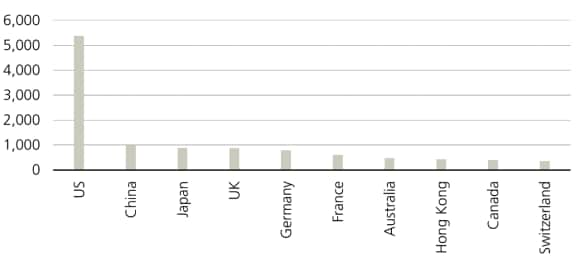Global real estate
Opportunities as market bottoms out

1. Why add unlisted real estate to your traditional 60/40 portfolio?
1. Why add unlisted real estate to your traditional 60/40 portfolio?
The paradigm for global inflation and interest rates may have changed, but unlisted real estate still has a key role to play in a multi-asset portfolio. The role of unlisted real estate and its required risk-return has changed as the risk-free rate has moved from zero and below. In general, private markets real estate offers investors several key benefits, such as bringing diversification to multi-asset portfolios. Real estate also has low and sometimes even negative correlations of returns with other asset classes such as bonds and equities.
Hence, adding unlisted real estate to an equity and bond portfolio can improve the risk-return trade-off and means that investors can achieve a desired return for a lower level of risk, giving them an enhanced opportunity set. Incorporating private markets can also create a path for investments which are unavailable in public markets. These investments can enhance income streams and provide good inflation protection, as well as the potential for long-term capital growth through good asset management. Private real estate can provide investors with the opportunity to have a sustainability impact, along with the opportunity to make a positive social impact too.
Global asset class total return correlations
29-yrs 1995-2023 inclusive | 29-yrs 1995-2023 inclusive | Government bonds | Government bonds | Corporate bonds | Corporate bonds | Equities | Equities | Listed real estate | Listed real estate | Unlisted direct real | Unlisted direct real | Unlisted real estate funds | Unlisted real estate funds |
|---|---|---|---|---|---|---|---|---|---|---|---|---|---|
29-yrs 1995-2023 inclusive | Government bonds | Government bonds | 1.00 | Corporate bonds | 0.63 | Equities | -0.04 | Listed real estate | -0.02 | Unlisted direct real | 0.05 | Unlisted real estate funds | 0.00 |
29-yrs 1995-2023 inclusive | Corporate bonds | Government bonds | - | Corporate bonds | 1.00 | Equities | 0.39 | Listed real estate | 0.40 | Unlisted direct real | 0.13 | Unlisted real estate funds | -0.15 |
29-yrs 1995-2023 inclusive | Equities | Government bonds | - | Corporate bonds | - | Equities | 1.00 | Listed real estate | 0.59 | Unlisted direct real | 0.40 | Unlisted real estate funds | 0.21 |
29-yrs 1995-2023 inclusive | Listed real estate | Government bonds | - | Corporate bonds | - | Equities | - | Listed real estate | 1.00 | Unlisted direct real | 0.59 | Unlisted real estate funds | 0.34 |
29-yrs 1995-2023 inclusive | Unlisted direct real estate | Government bonds | - | Corporate bonds | - | Equities | - | Listed real estate | - | Unlisted direct real | 1.00 | Unlisted real estate funds | 0.85 |
2. How should an investor think about investing domestically versus globally?
2. How should an investor think about investing domestically versus globally?
Investors typically make their first real estate investments in their domestic markets, before moving on to invest in other countries later. Their home market is the natural choice given they will be most familiar with it and its associated legal structures, tax system, supply, demand and other potential risk factors. This creates a strong home bias, which typically leads to over-exposure to domestic real estate and results in concentration risk. Moreover, home bias tends to increase during times of market volatility as investors understandably focus on the market they know best. In contrast, international investment offers investors a much larger, global real estate investment universe which can complement any domestic holdings they might have rather than being a substitute for them. The largest real estate investment markets in the world – the US, Japan, China, Germany, the UK – typically can offer opportunities across all the main real estate sectors of commercial, logistics, residential and hotels, as well as niche and specialist sectors.
However, smaller and developing markets often do not provide access to all sectors and more specialist and operational areas such as life sciences, student housing and self-storage. International investment can thus serve a different purpose in a portfolio, for accessing new and different property types and for diversification. Correlations of real estate returns across international markets are generally lower than between sectors within countries, in part because the economic and construction cycles vary strongly across markets. This means that investors can reap significant benefits from international property investment in terms of risk-adjusted return. Nevertheless, investing in a foreign market exposes an investor to risks and information asymmetries that can dilute returns. However, these can also be mitigated with expert advice.
Real estate market sizes, top-10 (end-2022, USD billions)
Real estate market sizes, top-10 (end-2022, USD billions)

3. How has the role of real estate in a portfolio changed with the shift to higher interest rates and higher inflation?
3. How has the role of real estate in a portfolio changed with the shift to higher interest rates and higher inflation?
In the stabilized post-pandemic world, higher interest rates mean investors are expected to receive a higher yield on real estate investments. Real estate typically offers a risk or yield premium compared to government bonds to compensate investors for the increased risk of the investment, such as occupiers defaulting on rental payments. It is debatable as to whether the real estate risk premium will rise or fall compared to the golden period prior to the Global Financial Crisis (GFC) and the easy money period of ultra-low interest rates following the GFC. Compared to the golden period, global real estate markets are more mature, more liquid and offer more investment options. This would argue for a lower risk premium.
By contrast, the easy money period saw investors flock to real estate. They looked to generate a positive yield as interest rates in the government bond market, especially in Europe and Japan, turned negative. This resulted in sharp downward pressure on real estate risk premiums. Given that in the post-pandemic era we expect interest rates and bond yields to be higher, we also expect some increase in the risk premium on property as investors are able to generate an income from risk-free government bonds again.
4. Can real estate still achieve competitive returns in this environment?
4. Can real estate still achieve competitive returns in this environment?
Property valuations had to adjust to the higher interest rate world. More specifically, the discount rate applied to future income flows had to rise to reflect a higher risk-free rate. That repricing is now well-advanced and once it has completed, there is every reason to expect that good quality, well managed real estate can achieve competitive returns. Particularly the type of real estate that is in demand from tenants e.g., living assets, logistics, health-related facilities and grocery-anchored retail. However, the emphasis will be on good asset management in order to generate rental growth. A manager who can drive tenant interest and retention, not in the property sub-types just mentioned, will be able to generate returns that deliver on the required risk premium and remain competitive in a multi-asset portfolio.
5. Are there strategies that are better suited to outperform in this environment?
5. Are there strategies that are better suited to outperform in this environment?
The pillars of a successful real estate investment strategy are the same irrespective of sector and geography: good location and sound asset management. Structural tailwinds driving tenant demand for the specific types of real estate mentioned are also important factors. Finally, particularly at this stage of the cycle where values have corrected sharply, returns can be enhanced by an attractive basis of entry. But these factors are always true, to one degree or another, for real estate. In this higher interest rate environment, the emphasis should be placed even more strongly on sound asset management, because the market yield compression that benefited all investments during the post-GFC decade of easy money is gone. A good manager is more important than ever because income and rental growth will be the predominant driver of returns in this next stage of the cycle.
6. What are the biggest risks to the asset class given today’s outlook?
6. What are the biggest risks to the asset class given today’s outlook?
As long as an investor ensures to carefully select their asset class mix, locations and good asset management, the biggest risk to sustaining value in real estate predominantly rests within the broader economy. There is the risk that core inflation rebounds or proves sticky and interest rates and discount rates need to rise further. This would extend the downward pressure on real estate capital values and increase the risk premium on property.
This is likely the biggest potential threat to a recovery, at least at the market level. Another risk is any downturn or recession in the economy, since ultimately economic growth tends to fuel occupier demand for real estate and drive rental growth. Investors also need to carefully manage and think about demographic changes and their impact, such as ageing populations. However, this can also present opportunities in specific types of real estate addressing this, such as accommodation catering to the needs of the elderly population.
Want more insights?
Want more insights?
Subscribe to receive the latest private markets perspectives and insights across all sectors directly to your inbox.
Make an inquiry
Fill in an inquiry form and leave your details – we’ll be back in touch.
Introducing our leadership team
Meet the members of the team responsible for UBS Asset Management’s strategic direction.


